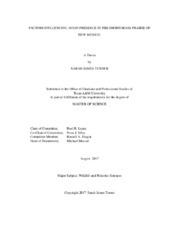| dc.description.abstract | The Department of Defense owns the management rights to over 12 million hectares of land used for training maneuvers in the name of national security. A caveat of using these lands is the requirement to comply with federal environmental legislation, even when this conflicts with the successful attainment of the military mission. One complex ecological issue dealt with by the Department of Defense is the monitoring of migratory birds, as their presence serves as an indicator of ecological viability and additionally creates a major training impediment.
Melrose Air Force Range, located in the high plains of eastern New Mexico, is a live fire bombing and gunnery range administered by Cannon Air Force Base. It is a highly disturbed subset of the shortgrass prairie subject to intense land modification actions. In order to comply with federal mandates, migratory and breeding bird surveys were conducted in spring, summer, and fall of 2015 and 2016. From these surveys, variation between survey years, seasons, and vegetative subsets were determined using CAP discriminant analysis and redundancy analyses were conducted to determine which environmental, locational, or anthropogenic factors provided the most influence on avian presence. My study found that soil composition, precipitation, and temperature explained the highest proportion of variation in avian presence. Additionally, it was determined that anthropogenic factors were able to explain a portion of the observed variance, although the true extent of anthropogenic influence was not able to be assessed due to the fact that Melrose Air Force Range itself is the product of extensive anthropogenic modification. My study suggests that while the vegetative structure and associations that emerge as a function of biotic and abiotic conditions (temperature, precipitation, soil composition) are important determinants of avian community composition, the introduction of anthropogenic factors (land use and management) alters the underlying spatial distribution of resources (i.e., function as a disturbance to create more exploitable niches), and therefore can increase avian richness and diversity. This change is inversely proportional to scale, with higher diversity at finer scales and increased homogeneity at broader scales. | en |


